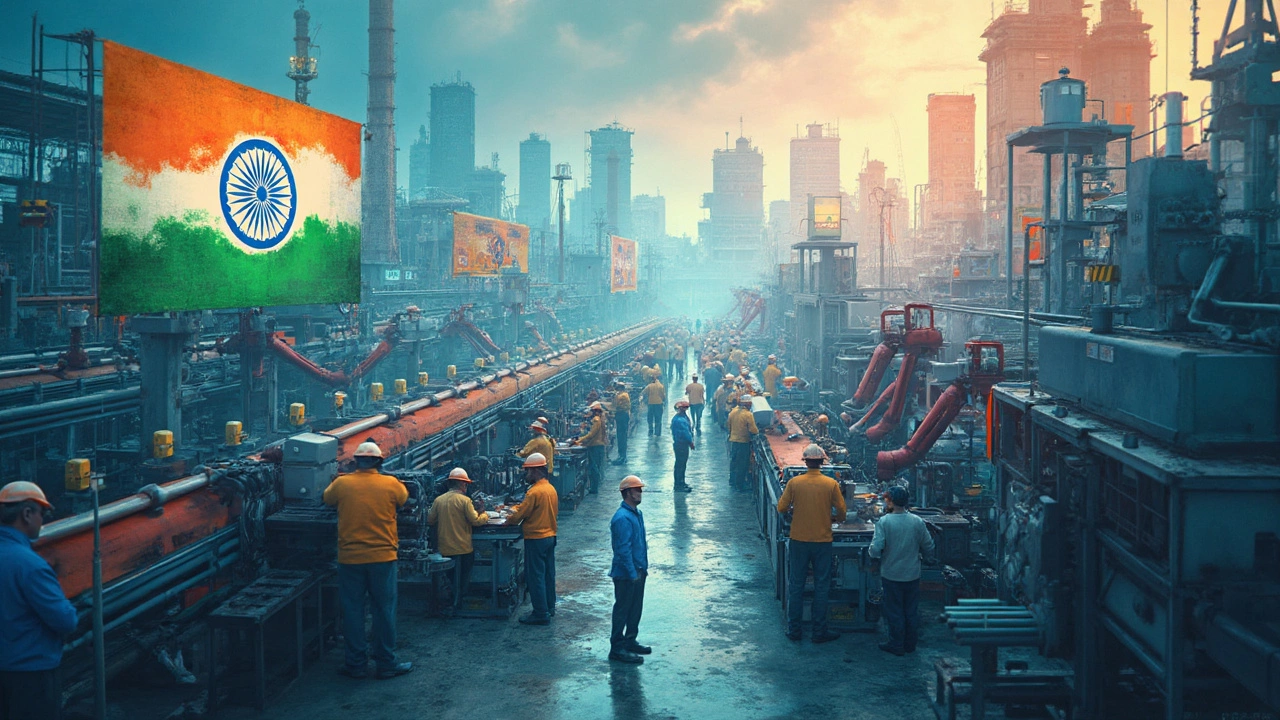Ask anyone where most of the world’s goods roll off the assembly line, and you’ll hear the same answer: China. It’s not just about cheap toys or electronics anymore—China rules everything from steel to solar panels to high-speed trains. The numbers back it up. As of 2024, China’s factories pump out almost 30% of all manufactured stuff globally. That means nearly one in three products you touch probably took its first breath in a Chinese factory.
But is it really that simple? It’s not just cheap labor or massive cities full of workers. There’s a blueprint behind the success—a mix of smart government policies, big spending on tech, and a non-stop push for exports. China’s government doesn’t just talk about making things; it builds roads, backs up companies with easy loans, and even dishes out tax breaks for mega-factories. Secret sauce? Maybe. But anyone serious about manufacturing can’t ignore these moves.
- China: The Undisputed Giant
- India’s Manufacturing Ambitions
- Game-Changing Government Schemes
- What Businesses Can Learn
China: The Undisputed Giant
It’s impossible to ignore China when you talk about the manufacturing capital of the world. For over a decade, China has been the go-to hub for making almost everything— from your phone to the shoes on your feet. The numbers don’t lie: in 2023, China’s manufacturing output hit $4.9 trillion, dwarfing its closest rivals like the US and Germany. Here’s a quick look at how the major players stack up:
| Country | Manufacturing Output (2023, USD Trillion) | Global Share (%) |
|---|---|---|
| China | 4.9 | 29 |
| United States | 2.5 | 15 |
| Germany | 0.8 | 5 |
What’s the secret sauce? China’s got four big things going for it:
- Massive Workforce: Over 112 million people work in manufacturing. That’s more than the entire population of some countries.
- Infrastructure: High-speed trains, mega-ports like Shanghai, and efficient supply chains mean goods move fast—sometimes from factory to ship in 24 hours.
- Government Support: The government rolls out special zones where taxes are low and setting up factories is a breeze. Whole cities like Shenzhen exist because of government pushes to focus on tech and export manufacturing.
- Technology and Scale: China doesn’t just assemble your gadgets anymore—it builds the robots that do the work. In 2024, they accounted for over 52% of industrial robots installed globally.
But it’s not just about size. The variety is wild: China leads in electronics, steel, textiles, electric vehicles, and even green tech like solar panels. Notably, in 2023, China produced more than 75% of the world’s solar panels and close to 60% of electric vehicle batteries.
For businesses, this dominance means that if you’re sourcing products at scale, China is still king. Don’t forget, policies like "Made in China 2025" and steady investments in research keep moving the needle, helping local firms climb the value chain and push into high-tech territory. Even after recent global supply chain shocks, China bounces back faster than most. No wonder it’s called the workshop of the world.
India’s Manufacturing Ambitions
India is not just watching China’s rise from the sidelines—it's jumping headfirst into the race to be the next manufacturing capital. Over the past few years, India has put out some huge numbers. By 2024, India’s manufacturing sector contributed around 17% of the country's GDP, and the government isn’t shy about its goal to push that to 25%.
Why is India going all-in on manufacturing? For one, there’s the obvious need for jobs—a whopping 12 million young people join the workforce every year. Plus, there’s a hunger for growth and economic clout to match China.
The government rolled out the “Make in India” campaign back in 2014, aiming to turn the country into a global factory. Factories aren’t just popping up in Mumbai or Chennai; special economic zones are coming up all across the map, slashing red tape, taxes, and import duties for manufacturers. Incentives are available for sectors like electronics, textiles, and vehicles. You also see programs like “Production Linked Incentive” (PLI) schemes, which straight-up pay out to companies hitting set production goals.
| Year | India’s Manufacturing GDP (%) | No. of PLI Schemes |
|---|---|---|
| 2015 | 15.1 | 0 |
| 2020 | 16.4 | 3 |
| 2024 | 17.0 | 14 |
Big global companies are taking the bait. Apple now assembles iPhones in India, while Samsung has set up one of its biggest smartphone factories near Delhi. India is trying to woo electronics, pharma, and automotive giants with the carrot of a massive local market and easy export rules.
If you’re running a business or thinking of starting something in manufacturing, it’s smart to check out the government’s schemes and incentives. Dig through the “Make in India” website, talk to local officials, or even look at India’s export-import policy updates—there’s real money and long-term perks on the table right now.

Game-Changing Government Schemes
China didn’t just wake up as the manufacturing capital overnight. Its government rolled out a pretty intense playbook to get ahead. The most famous is "Made in China 2025." This plan wasn’t about cranking out more t-shirts. It focused on stuff like robotics, semiconductors, and electric cars. Factories got support to move up the value chain. If a company tackled tech that the country needed, the government would throw loans, land, or even tax cuts their way.
Here’s the kicker: government help wasn’t just nationwide. Provinces started fighting to attract the best manufacturers with their own perks. For example, Shenzhen became a tech epicenter by offering cheaper land, quick permits, and linking local companies with global investors. This hyper-local effort pulled in both small workshops and massive brands.
India’s story is picking up pace too. The Modi government’s “Make in India” scheme, launched in 2014, rolled out a welcome mat for global and local firms. The goal? Boost the share of manufacturing in GDP to 25% by streamlining rules, slashing red tape, and giving tax breaks for new plants. The Production Linked Incentive (PLI) scheme is another big move—paying firms for every phone, appliance, or auto part made locally. Apple started building more iPhones in India because these sweeteners suddenly made it a cheaper, smarter move.
Other countries are taking notes. Vietnam hands out free land for building new factories, and Indonesia gives import duty exemptions for equipment that sets up new plants. The result? Southeast Asia is snatching up more contracts as companies look for alternatives outside China.
| Country | Flagship Scheme | Launched | Main Perks |
|---|---|---|---|
| China | Made in China 2025 | 2015 | Loans, tax breaks, R&D funding |
| India | Make in India & PLI | 2014/2020 | Tax breaks, cash incentives, rule changes |
| Vietnam | FDI Initiatives | Ongoing | Land, tax holidays, customs perks |
| Indonesia | Investment Incentives | Ongoing | Import duty exemptions, tax breaks |
The takeaway? Government schemes can give a huge head start, but they need to keep evolving. Just copying China’s old model won’t work forever. Tech, environment rules, and global politics change the game every year. The real winners will be countries that stay quick on their feet with new ideas and adaptable policies.
What Businesses Can Learn
If you want a piece of global manufacturing, pay attention to what’s actually working. China’s playbook isn’t a secret, it’s just that few places have pulled it off with the same drive. Let’s break it down so you know what to watch, borrow, or just flat-out copy if you’re thinking big.
First, government backing is massive. Take China’s "Made in China 2025" plan. The government pumped nearly $300 billion over a decade into tech and heavy industry. This isn’t about handouts—it’s about investing in robotics, semiconductors, and new energy vehicles. When government and business pull in the same direction, big things happen.
Second, look at how supply chains work there. If you’ve got access to dozens of suppliers in a single city, you can cut costs, speed up production, and fix hiccups before outsiders even notice. This tight network makes it tough for competition to keep up. As an entrepreneur or CEO, locating close to a hub like this can be game-changing.
“The manufacturing powerhouse has been built through long-term state support, skilled labor, and quick adaptation to market needs.” — World Economic Forum, 2024
India is also taking notes, throwing out their manufacturing capital ambitions with the "Make in India" scheme. The government rolled out fast-track permits, set up industrial corridors, and cut corporate taxes for new manufacturers to 15%. In 2023, India saw a 13% jump in manufacturing FDI flows. That’s growth you can’t ignore.
So, what steps can a business take to get ahead?
- Find out if local government offers production-linked incentives: These can mean cashbacks, tax breaks, or even free land, just for setting up shop or hitting export targets.
- Cluster with industry peers: Set up near similar manufacturers to tap shared suppliers, talent, and logistics—think Shenzhen or Pune, not the middle of nowhere.
- Invest in tech adoption: Smart factories and automation don’t just cut labor costs—they ramp up quality and speed too.
- Keep an eye on trade policy: Movement in tariffs and import/export rules can make or break your profit.
Here’s a quick look at fresh data comparing support tools for manufacturers in China and India:
| Country | Government Scheme | Tax Break % | Manufacturing FDI Growth (2023) |
|---|---|---|---|
| China | Made in China 2025 | 15-25 | 8% |
| India | Make in India, PLI | Up to 15 | 13% |
Copying what works isn’t cheating—it’s just smart business. Find the right location, push for tech, and don’t ignore how government schemes tilt the playing field. The road map is there, and the results are hard to argue with.
